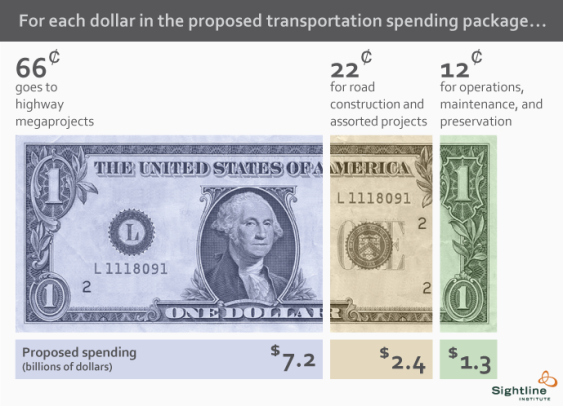Last Friday I complained that the transportation package currently being considered in Olympia elevates highways—and big, costly highway megaprojects in particular—above all of the state’s other transportation needs, from rail freight to transit to bike and pedestrian projects to protecting streams and rivers from the damage done by roads. Environmentalists should view it as a terrible deal.
But from the standpoint of fiscal responsibility, the House transportation package is also a bust: even as it splurges on new highways, the package offers only a pittance to maintaining and preserving the ones we’ve already built. Take a gander:
Anyone who’s taken a serious look at the issue thinks that the green bar represents just a small fraction of what’s required to maintain and preserve Washington’s transportation infrastructure. The Washington Roundtable, for example, thinks that the state needs to spend about 3 times as much on road preservation as this budget gives. And if we shortchange preservation now, it’ll be that much more expensive to fix things later. (A shovel in time saves nine…)
What makes this so galling is that transportation leaders consistently give lip service to road maintenance and repair. That’s probably because it polls so well: 88 percent of respondents in a recent survey said that maintaining and preserving existing roads was a “top” or “high” transportation priority, beating the pants off of every other option mentioned. And yet the House proposal would spend billions on new construction—and actually create an entirely new megaproject—even as it devotes just a fraction of what’s needed to maintain the roads we’ve already built.
The numbers tell the truth here: any attempt to call this a “fix it first” package is a brazen lie.
Graphic by GoodMeasures.biz.










Benn
This article seems says that the proposed funding package is a disaster for environmentalists, but then goes on to make the argument that it is really the fiscal issues that matter. Which one is it? The fiscal angle is fine, but if the author wants to go there, they should be prepared to offer a more nuanced evaluation that what has been presented or just stick to the environmental arguemnt where he may have more traction.
As with any good “fiscal” argument you need look at the net, not the gross. The transportation package is as much about transportation as it is about jobs. Do I think it is a good thing? Does not matter, because that is the reality of it. And new construction projects, especially long term “mega projects”, do more for both direct and indirect jobs in the short term than distributed maintenance work at a macroeconomic level. So while the gross cost of new work is higher, the gross benefits are also higher. Then you also have the issue lifecycle costs. The reality is that roads or any other infrastructure reach a point where the O&M costs begin to increase in higher proportion to their net benefit. The curve starts to get particularly steep when there are functional deficiencies involved at either at a structural or systematic level. And guess what, the general lifecycle of most infrastructure is in the range of 50 years. When was most of our current infrastructure build? Fifty to 60 years ago. Many roads and bridges are at the point where continued expenditures for O&M is just throwing good money after bad. And finally there is the fact that not all cost for “new” roads are additive. In many instances, the cost if “new” infrastructure replaces or lowers the O&M costs for existing infrastructure, particularly for structures like bridges or where new routes take traffic off existing routes, such as the 509 project.
Clark Williams-Derry
I think that both environmental and fiscal issues matter. I covered the environmental issues in a previous post; this one just covers fiscal ones.
I agree that O&M aren’t enough to keep existing infrastructure in good working order. We’re now at the point where a significant chunk of our transportation infrastructure needs major refurbishment—often called “preservation” rather than “maintenance”—not just patchwork O&M. As you point out, some roads are starting to reach the point where O&M isn’t a good investment. Parts of I-5, for example, are nearing the tipping point where they need repaving, not just routine maintenance.
But there’s effectively NO money in the house package for preservation. The Washington Roundtable transportation budget suggested $914 million for O&M, and $1.9 billion for preservation. It seems to me that the House budget started with the Roundtable recommendations, stripped out the $1.9 billion to fund a new megaproject, and lumped “preservation” in with O&M for a total of $911M for all three.
There’s more to be said, but I think we agree about many things: O&M isn’t enough; much of our existing transportation infrastructure is nearing the point where it needs to be repaved or rebuilt. I think we can both agree that there’s very little money in the budget for preservation/repaving of existing right of way. We may disagree about the 509 project; regardless of any truck diversion, I-5 will still need attention, but there’s no money in this budget for it.
But I’m struck by the fact that the House budget is a “fix it first” budget only in rhetoric, not in substance. It’s like we have a house with a leaky roof and a cracked foundation; but we’re spending all our money on a fancy kitchen remodel and a brand new rec room addition.